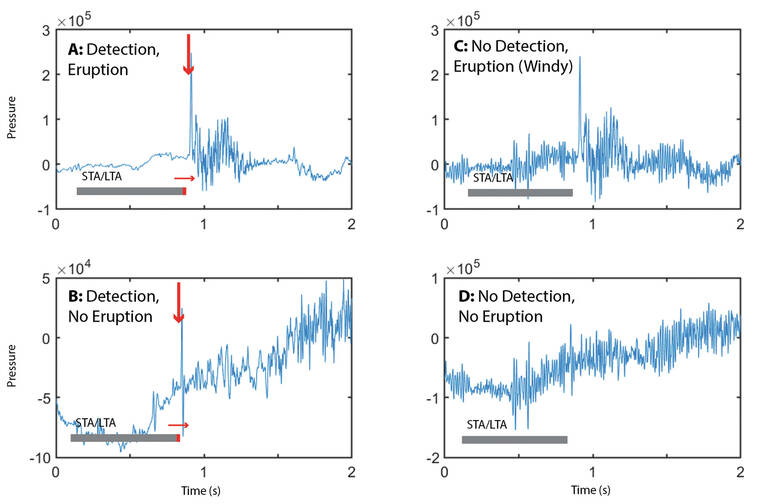Volcano Watch: What sounds the (automated) alarms at HVO?
The USGS Hawaiian Volcano Observatory keeps its eyes on active volcanoes in many ways. While old fashioned eyes and a notebook are used when field teams are near a volcano, modern volcano observatories also utilize rapidly collected data and computers to support monitoring.
Because it can be very expensive to have scientists watch the volcano data streams on a 24-hour basis, HVO computers are ‘trained’ to look for activity and alert when the volcano is changing or becoming active. They look at a wide array of observations including seismic (ground shaking), infrasound data (air pressure), ground deformation, as well as camera image assessments.
ADVERTISING
As the data from these systems enter a computer, they can be assessed as close to the time of collection as possible. If an observation is unusual, the computer can send a message to make a scientist aware at any time of the day or night.
At the core of many alarm systems is an often-simple computer program which looks for a change in energy from shaking of a seismometer or a burst of sound on an acoustic sensor. If the sensor is usually quiet and then the burst of energy occurs, then this can be detected by the computer which can send an automated message to a scientist. This type of energy burst detector is called a short-term average/long-term average (STA/LTA) detector.
During eruptions, changes in the air pressure are recorded on sound detecting sensors (like microphones), called an infrasound or acoustic array. The figure shows how a successful detection of an eruption might work using infrasound data and how the system may fail to detect an eruption.
The first image (A) shows an eruption that creates pressure changes recorded by the sensor. The detection (marked by a red arrow) would be easy to determine using an STA/LTA method, discussed above and shown as the grey and red bar at the bottom of panel A. The long-term average (grey bar) is a period before the eruption and the short-term average (red bar) shows when the eruption energy is strong. In this case, the STA is much bigger than the LTA and we can set the computer to send a message when this specific condition occurs.
If we next consider the same sensor which has detected another burst (B), but this burst came from a non-eruption source (say a car, a helicopter or another event away from our volcano). In this case, the volcano scientist might be alerted by an event that wasn’t volcanic (a false detection). Next, we show a cartoon example where we have introduced wind noise (C) into the same eruption recorded in (A). In this case, the wind would be so strong that the eruption can only just be seen in the data by the naked eye but may not be visible to the computer’s STA/LTA detector. In the final example wind noise was added to the example which may have been a car or helicopter but not an eruption (D); in this case the non-eruption can only barely be seen in the data and was not detected by the STA/LTA detector.
The cartoon figures show four possible outcomes that can be used to assess how good an alarming system performs. They include: 1) detection of a real eruption (A), 2) a false detection of non-volcanic change (B), 3) failure to detect a real eruption (C) and, 4) not detecting any event of interest (D).
These four examples show how HVO scientists can assess the performance of our alarm systems to improve detection of volcanic events and minimize the detection of noise or other activity. The four examples coincide with the concepts of test conditions for alarms using the terms: true-positive (A), false-positive (B), false-negative (C) and true-negative (D). A good alarm system should include true-positives (volcanic events) and true negatives (non-volcanic events) and try to minimize false-positives and false-negatives. Too many false alerts equate to unnecessary loss of sleep during quiet periods for a volcano. In summary, alarm systems are an important and evolving part of HVO operations and are an example of how computers and technology are incorporated in monitoring.
Volcano activity updates
Kilauea is not erupting. Its USGS Volcano Alert level is ADVISORY.
Over the past week, earthquake rates beneath Kilauea summit and upper East Rift Zone were more than double that of the previous week. About 100 earthquakes were located beneath the summit, and about 226 were located in the upper East Rift Zone. Earthquake rates beneath the middle East Rift Zone were on par with the previous week. Ground deformation rates in the summit region showed increased inflation over the past week, while ground deformation rates near the September 15-20 middle East Rift Zone eruption site have slowed. Future intrusive episodes and eruptions could occur with continued magma supply.
Mauna Loa is not erupting. Its USGS Volcano Alert Level is at NORMAL.
Three earthquakes were reported felt in the Hawaiian Islands during the past week: a M3.1 earthquake 6 km (3 mi) SSW of Volcano at 1 km (1 mi) depth on Nov. 27 at 2:19 p.m. HST, a M3.5 earthquake 75 km (46 mi) ENE of Honomu at 32 km (20 mi) depth on Nov. 27 at 12:29 a.m. HST, a M3.1 earthquake 2 km (1 mi) SSW of Pahala at 30 km (18 mi) depth on Nov. 22 at 2:02 p.m. HST.
HVO continues to closely monitor Kilauea and Mauna Loa.





